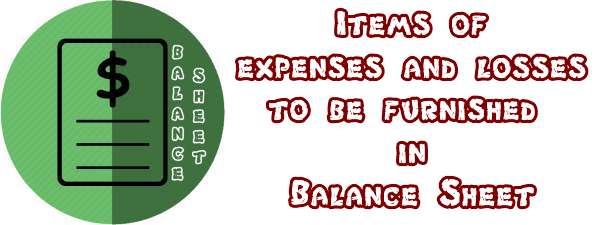Items of Expenses and Losses to be disclosed in Balance Sheet
Table of Contents
Items of Expenses and Losses to be disclosed in Balance Sheet
The expenses should be shown under suitable heads to the extent possible. Any expense, which exceeds 1% of the total revenue of the company or Rs.5,000 whichever is higher, should be shown as a separate item. The following items should be shown separately.
The following items of expenses and losses should be furnished in the appropriate of balance sheet as detailed below.

1. Raw Materials
In the case of manufacturing companies, the value of the raw materials consumed should be shown along with the item-wise break-up and the quantities thereof. But as no particular method has been laid down for classifying the raw materials, all important basic raw materials should be shown as separate items.
The intermediates or components procured from other manufacturers should also be added to the break-up of raw materials. But if their list is too large to be included in the break-up, they should be grouped under suitable headings in which case the quantities thereof need not be mentioned.
Further, the value of any item individually account for 10 per cent or more of the total value of the raw materials consumed should be shown as separate and distinct items along with their quantities. Hence, it is clear that all the small items can be grouped together and shown only with their value.
2. Stock of Finished Goods
In the case of manufacturing companies, the opening and closing stocks of goods produced along with the break-up in respect of each class of goods as well as the quantities thereof should be given. The items for which the company is holding separate industrial licenses will be treated as separate classes of goods for the purpose.
However if a company secures an exemption under section 211 from disclosing the above particulars a suitable note to the accounts should be given. If the particulars have not been disclosed and no exemption has been received, the auditor should qualify his report accordingly.
3. Purchases
In the case of trading companies, purchases and opening and the closing stocks are to be disclosed. Break-up should be given in respect of each class of goods traded in by the company along with the quantities thereof.
In case of the imported items, they should be classified in accordance with the classification adopted by the Chief Controller of Imports and Exports while granting import licenses.
In the case of a company which falls under more than one of the specified categories, viz. manufacturing, trading and service companies, the total amounts should be shown in respect of the opening and closing stocks, consumption of raw materials, purchases, and sales along with value and quantitative break-up.
If the list of purchases, stocks and turnover, items such as spare parts and accessories, is too large to be included in the break-up, they may be grouped under suitable headings without mentioning the quantities.
However, in case of these items, which in value individually account for 10 per cent or more of the total value of purchases, stocks or turnover, as the case may be, they should be shown separately along with their quantities.
4. Works-in-Progress
If a company has works-in-progress, its amounts at the commencement and at the end of the accounting period should be disclosed.
5. Expenditures that are to be Disclosed Separately
The following expenditures should be disclosed separately:
- Commission paid to selling agents.
- Commission paid to other selling agents.
- Brokerage and discount on sales excluding usual trade discount.
- Amount provided for depreciation, renewals or diminution in the value of fixed assets. If provision is not made through depreciation charge, the method adopted for making the provision should be disclosed. Further, if depreciation is not provided for the fact should be disclosed along with the amount of arrears of depreciation.
- Interest on debentures and other loans for fixed periods. The amount of interest paid or payable to the managing director and the manager should be shown separately.
- Consumption of stores and spare parts.
- Expenses towards Rent.
- Fuel and power.
- Expenses towards Repair to buildings, machinery etc
- Wages, Salaries and issue of bonus.
- Contribution to provident fund and other funds, Insurance etc.
- Expenses for workmen and staff welfare.
- Rates and taxes.
- Miscellaneous expenses.
- Losses on investments.
- Aggregate of amounts of provisions against specific liabilities.
- Provisions for losses of subsidiary companies.
- The amount of the charge for income tax and other taxation on profits should be disclosed.
